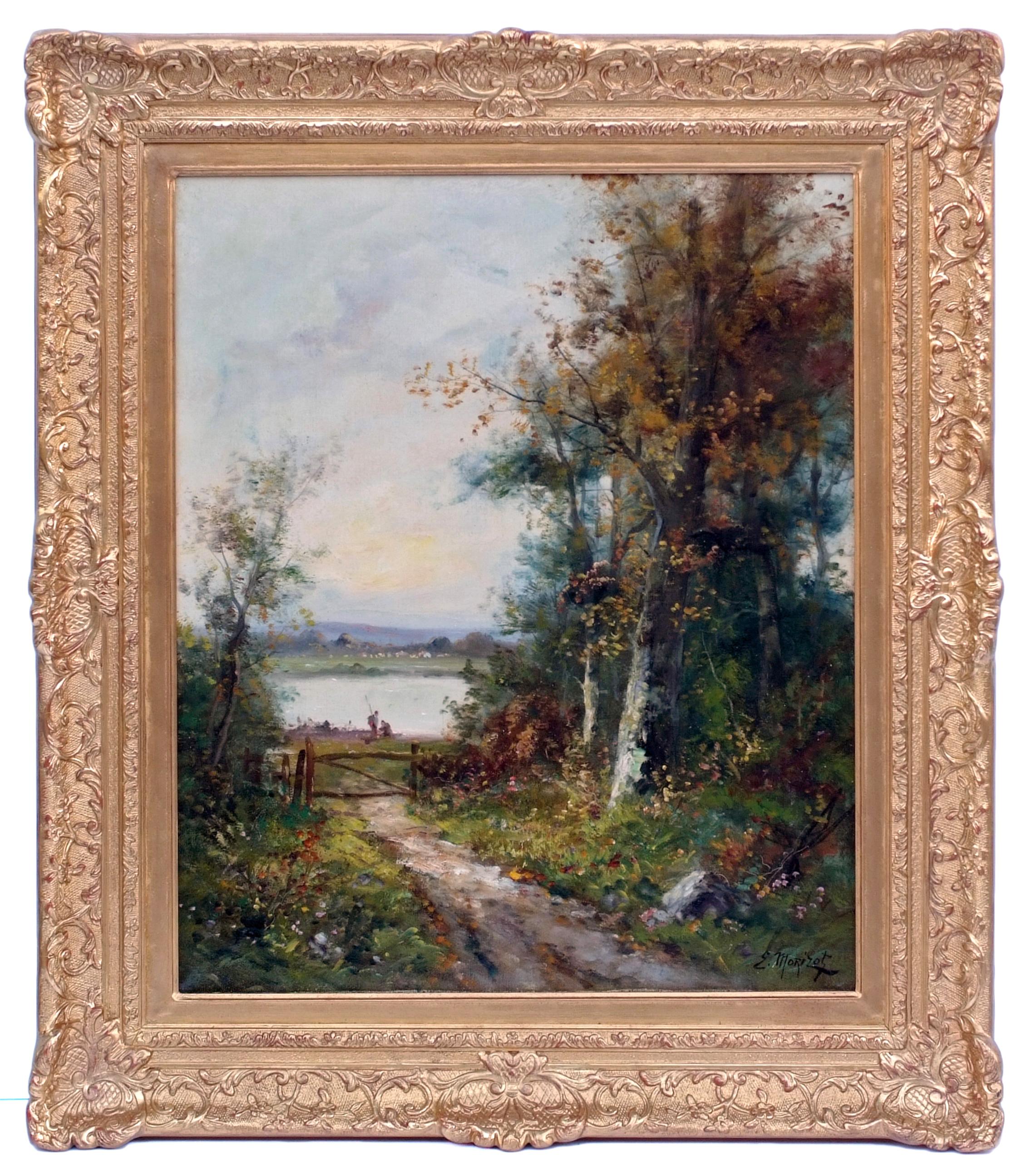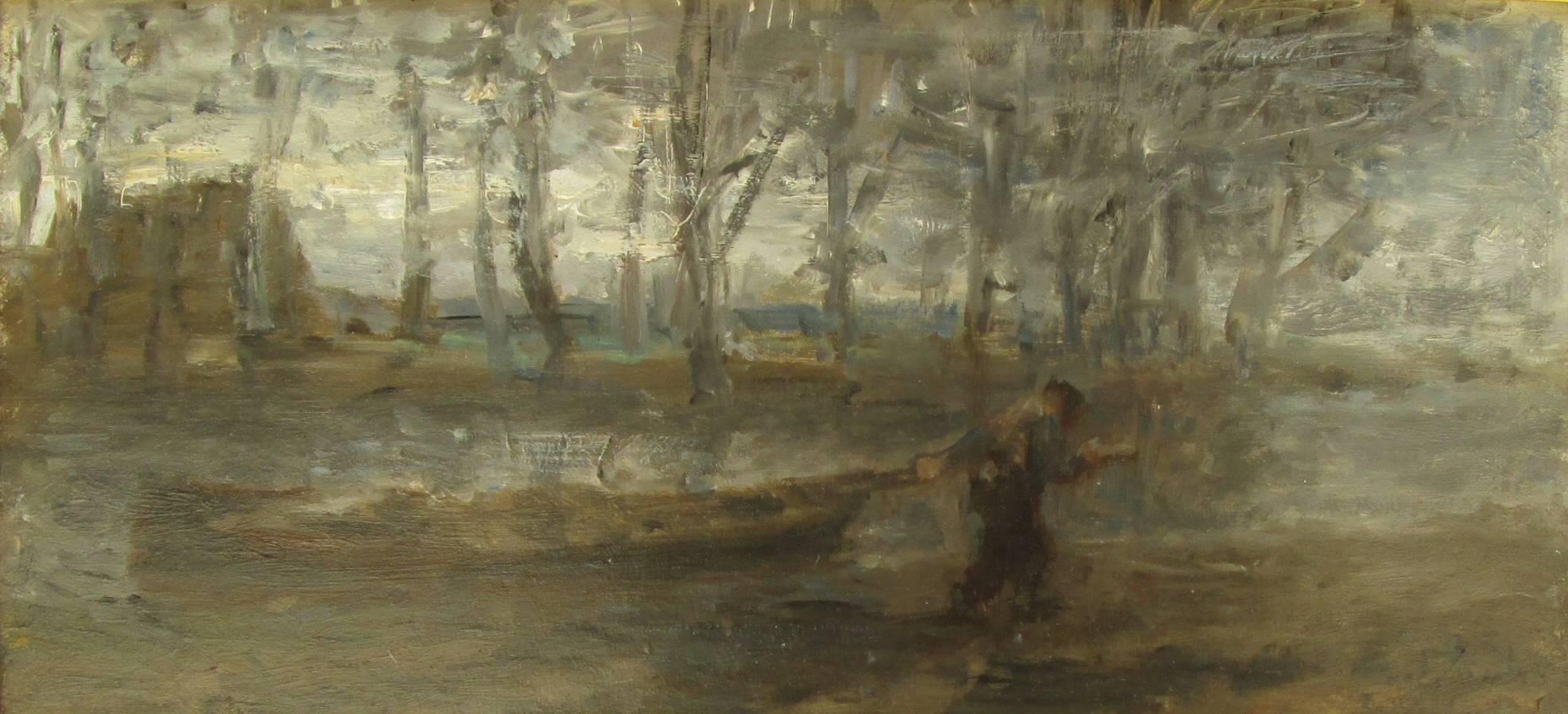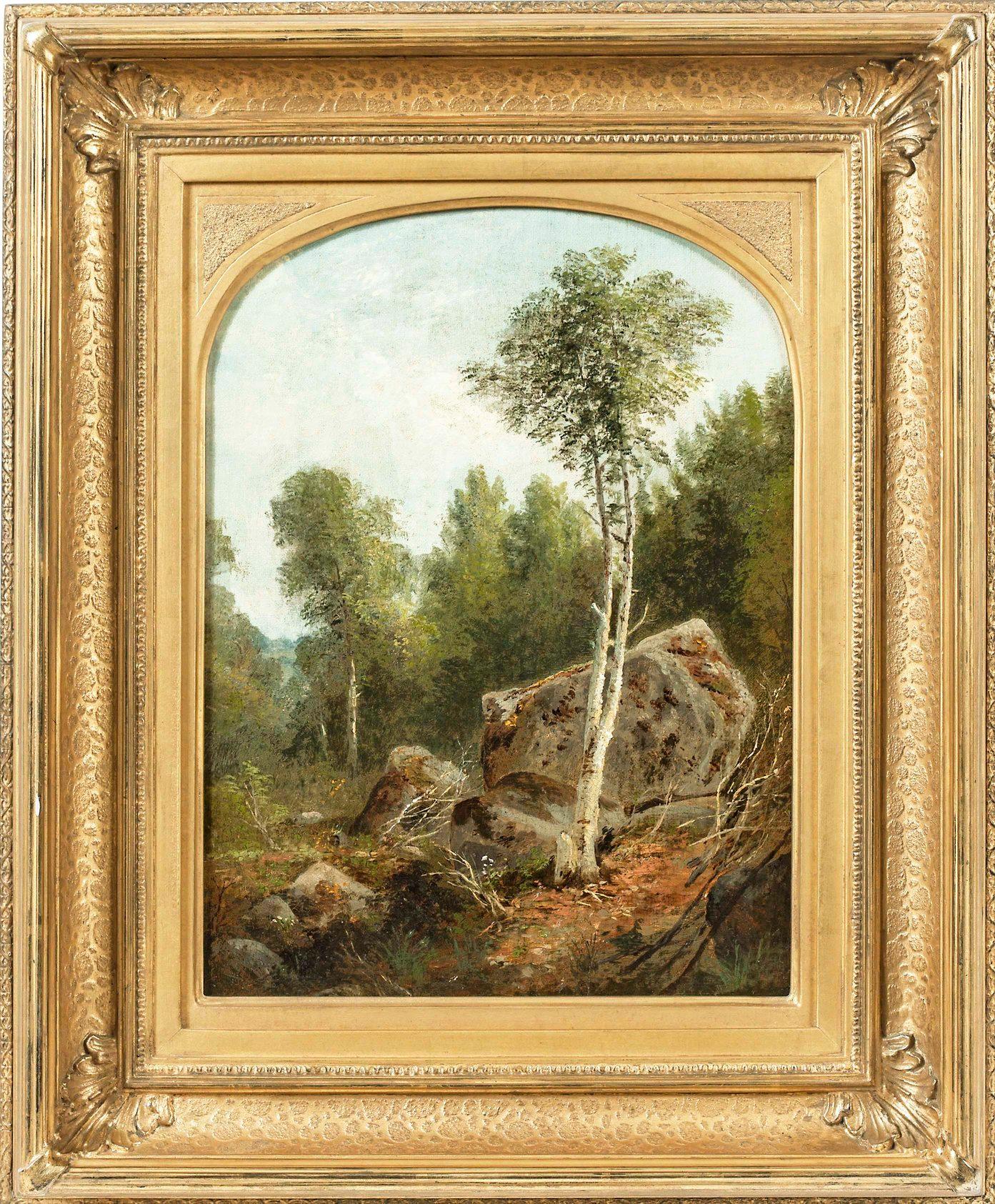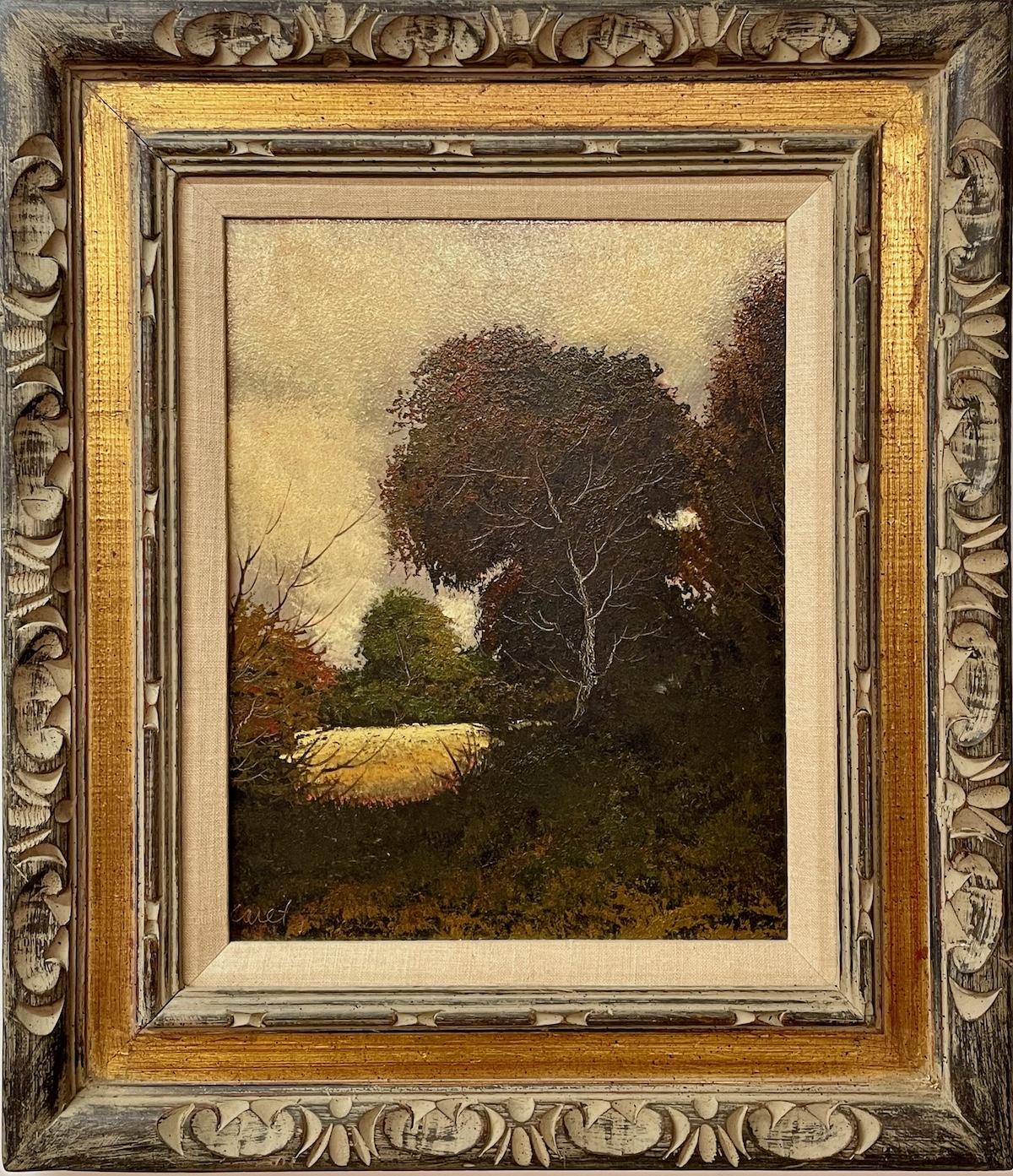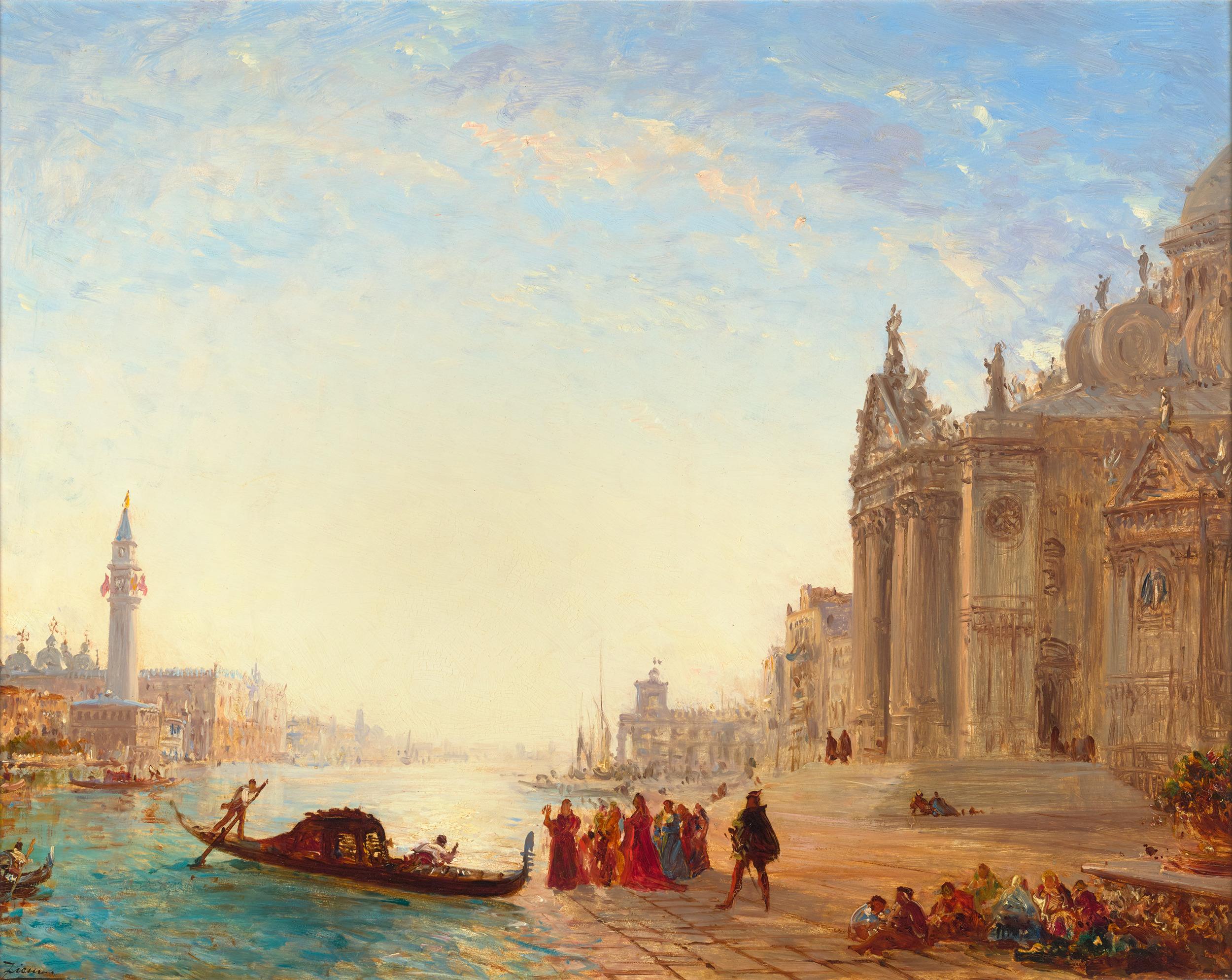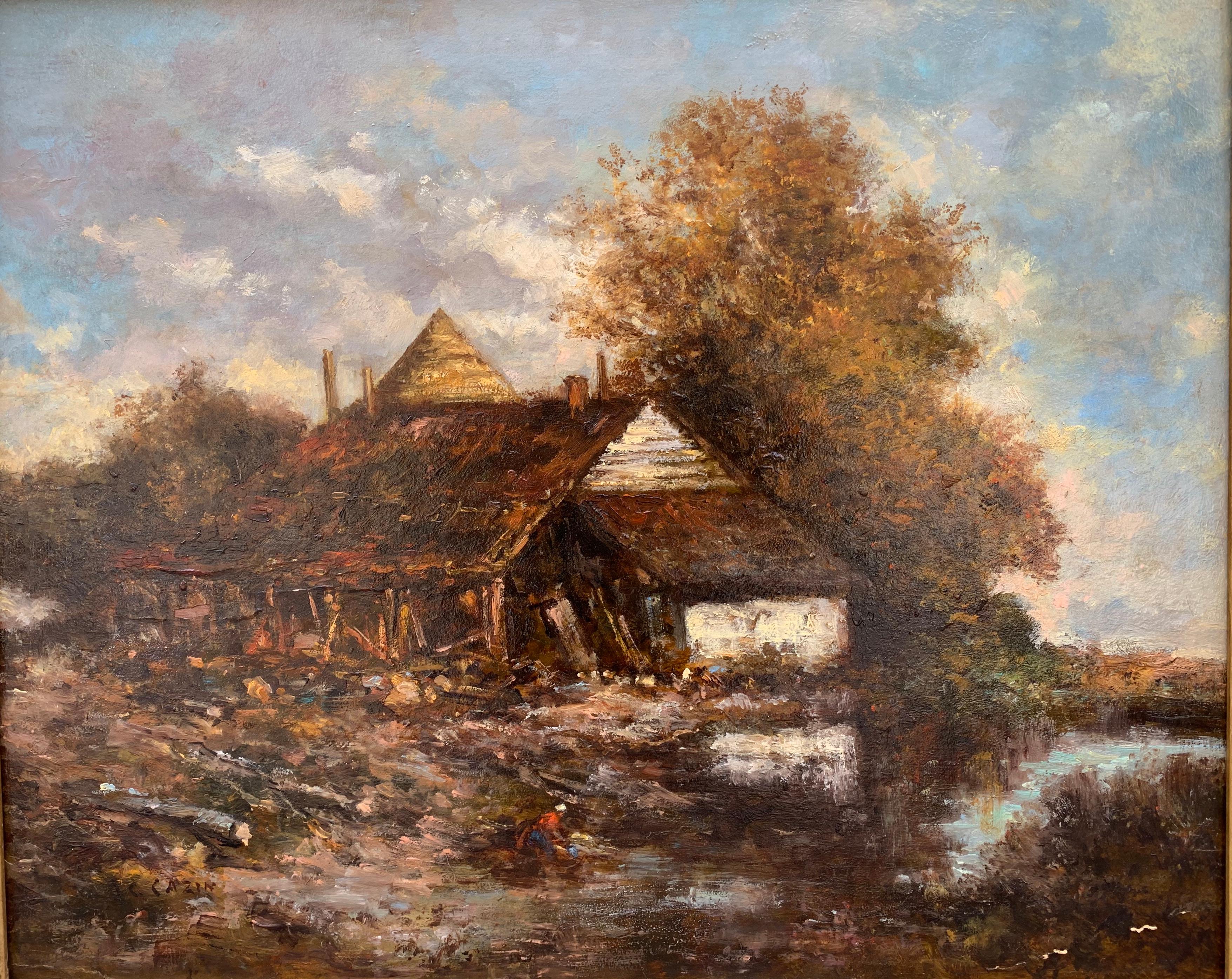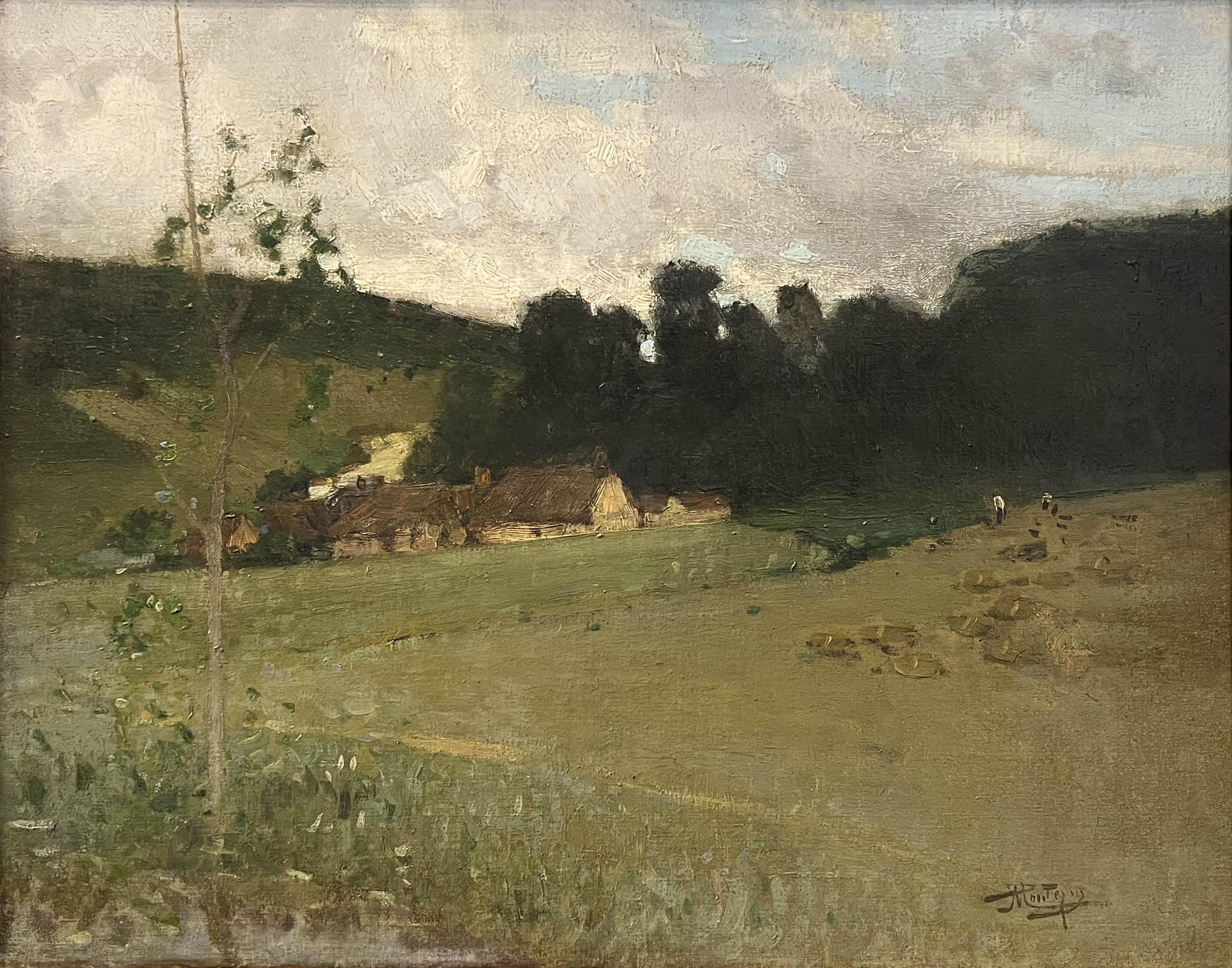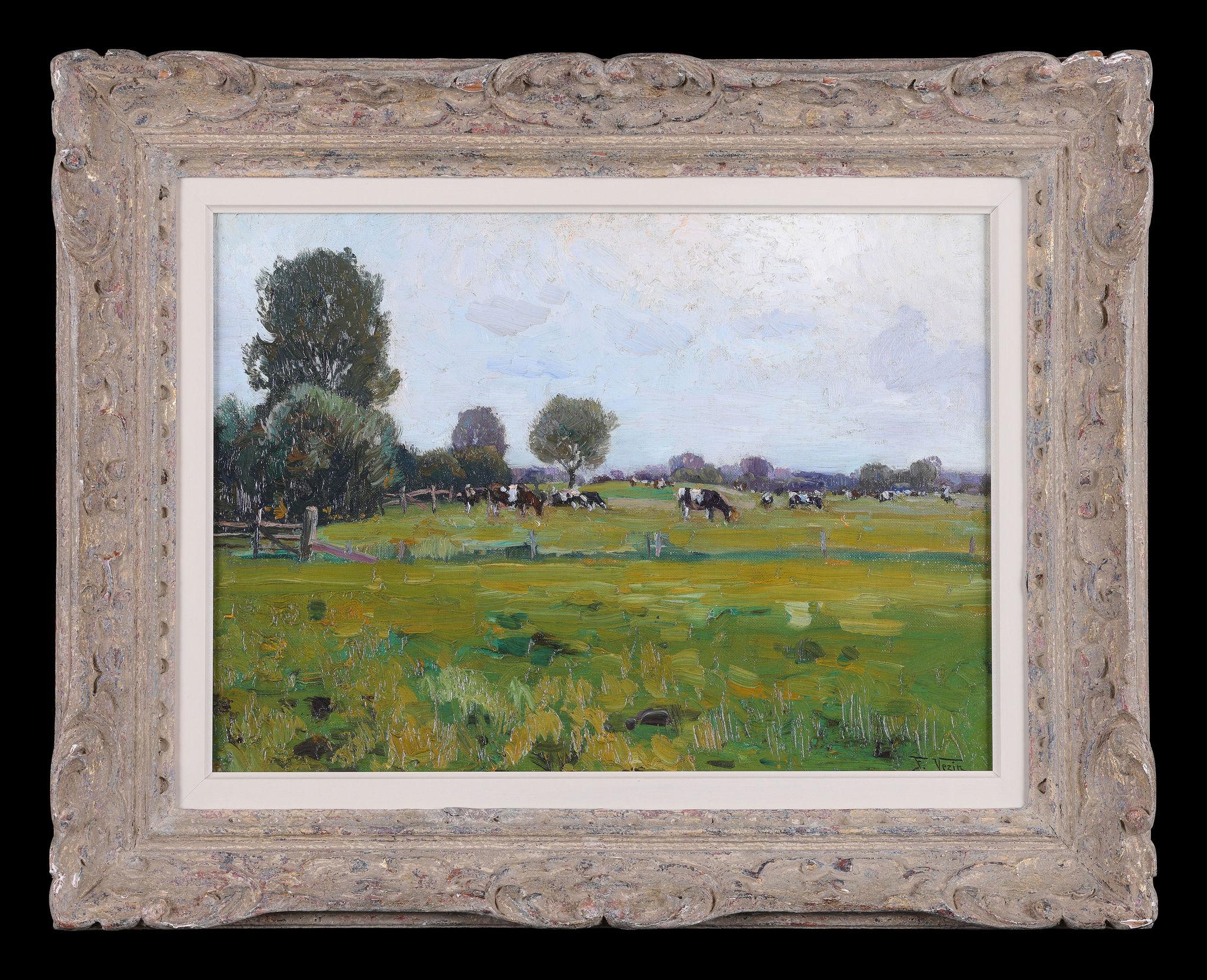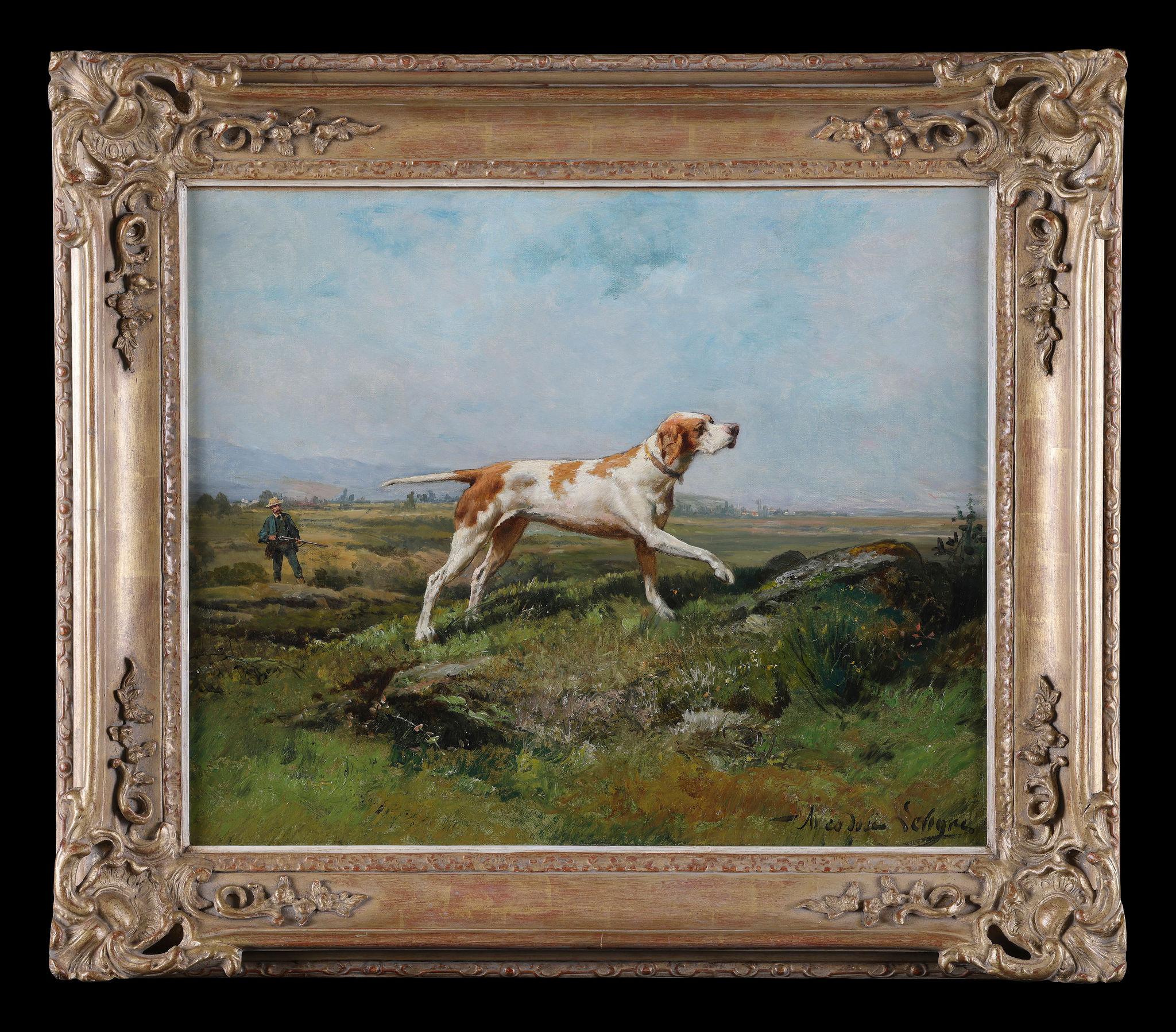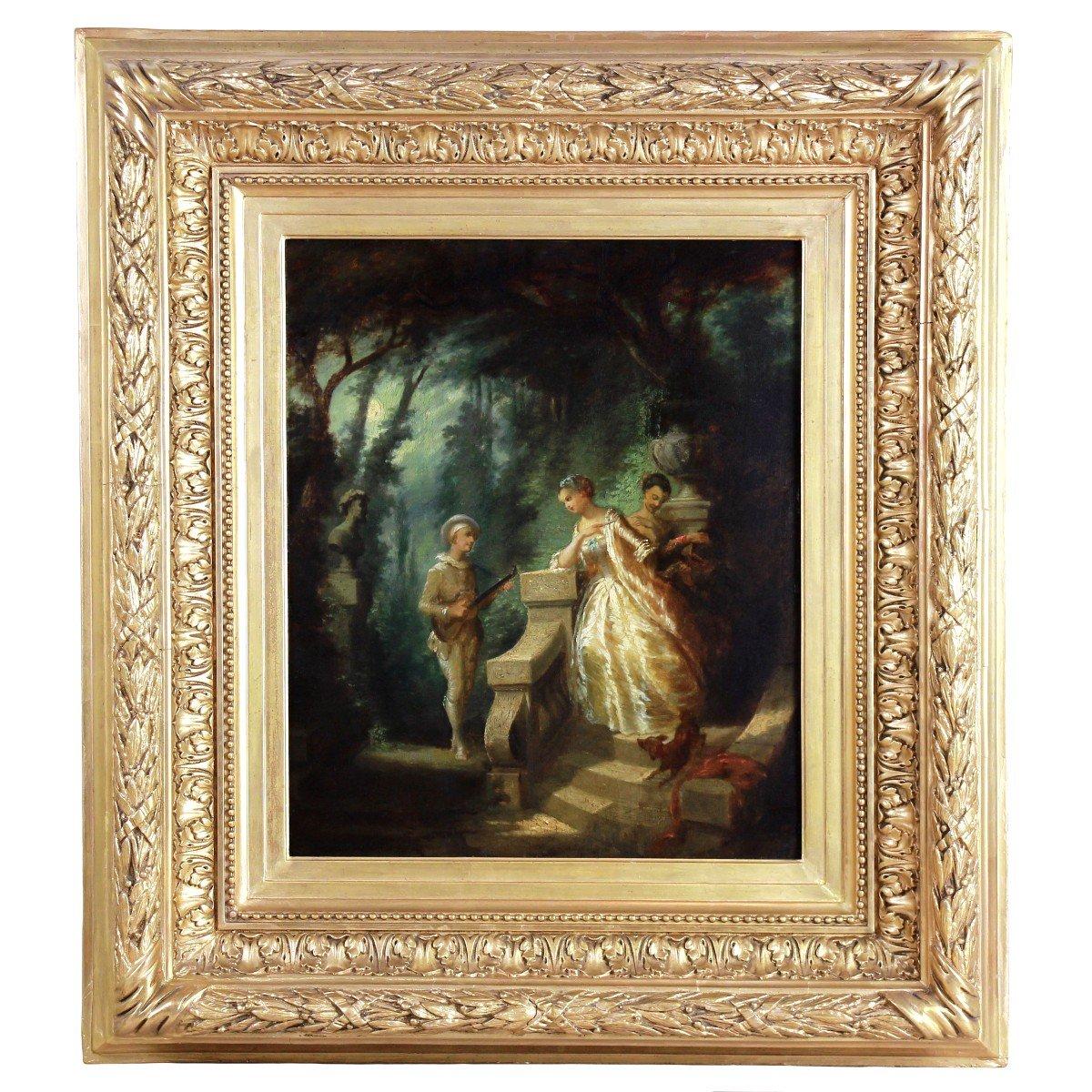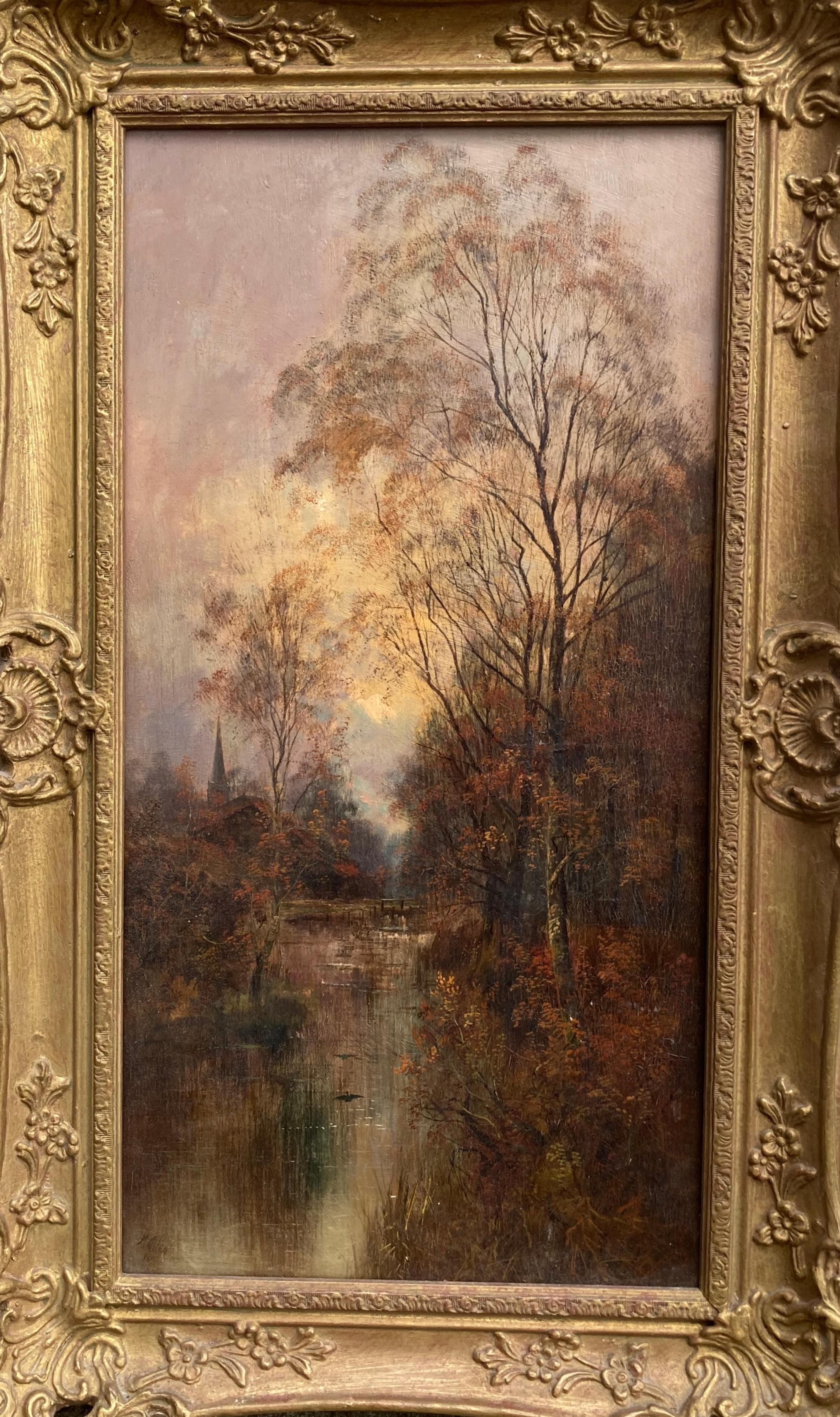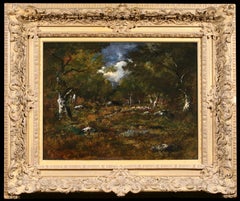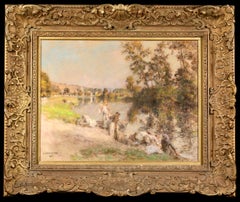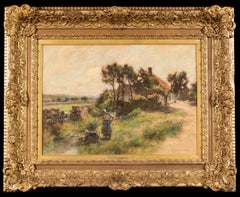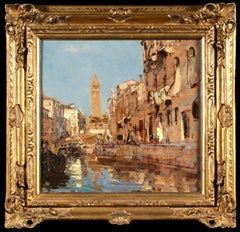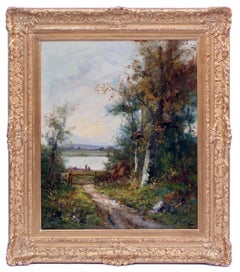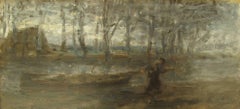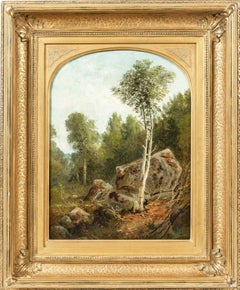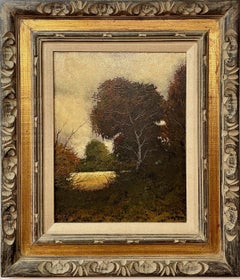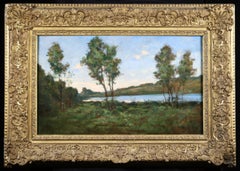
Bord de lac
View Similar Items
Want more images or videos?
Request additional images or videos from the seller
1 of 14
Henri Joseph HarpigniesBord de lacc.1910
c.1910
About the Item
- Creator:Henri Joseph Harpignies (1819-1916, French)
- Creation Year:c.1910
- Dimensions:Height: 26.5 in (67.31 cm)Width: 37 in (93.98 cm)Depth: 3.5 in (8.89 cm)
- Medium:
- Movement & Style:
- Period:
- Condition:
- Gallery Location:Marlow, GB
- Reference Number:1stDibs: LU415313707712
Henri Joseph Harpignies
Henri Joseph Harpignies was born in Valenciennes on June 28, 1819 and died in Saint-Privé onAugust 28 1916 He was a French landscape painter , watercolourist and engraver of the Barbizon School . Henri Harpignies' parents, Henri and Adèle, intended him for a commercial career, but his determination to become a painter led them to authorize him to enter Jean Achard 's studio in Paris in 1846. After two years of training, he left to travel to Italy .
Returning to France in 1850, Henri Harpignies joined Corot and the Barbizon School, whose influence he came under. Bound by friendship, the two artists traveled to Italy together in 1860.
In 1859, he collaborated in the decoration of the staff room of the Charité hospital in Paris.
On his return from Italy in 1861, he achieved his first success at the Salon with his Lisière de bois sur les bords de l'Allier . He then exhibited regularly at the Salon. In 1866, he received his first medal for Le Soir in the Rome campaign, acquired by the State . He then lived at 185, rue du Faubourg-Saint-Honoré in the 8th arrondissement of Paris before moving to 9, rue Coëtlogon .
During his very long career, Henri Harpignies painted a large number of works in Hérisson in the Bourbonnais , as well as in the Nivernais and Auvergne . He made decorative works for the Paris Opera , including the Val d'Égrie panel , which he exhibited at the Salon in 1870. He was a friend of Léon Bonnat , who twice made his portrait in 1889 ( Musée des Beaux-Arts). He painted the stained glass windows of the Château de Trousse-Barrière in Briare in 1895. In 1898, he was named Rosati d'honneur .
Anatole France called him “the Michelangelo of trees and peaceful countryside” .
At the end of his life, he was nearly blind.
He is buried in the cemetery of Saint-Privé ( Yonne ) .
His works are held in numerous ublic collections :
Such as Landscape with a City in the Distance (c.1865), watercolor, New York , Metropolitan Museum of Art .
Montreal Museum of Fine Arts : Moonlight (1889)
National Museum of Fine Arts of Quebec : Mountain landscape
Tulsa , Philbrook Museum of Art : Briare Railroad Bridge .
Washington , National Gallery of Art : Landscape in Auvergne .
Buenos Aires , National Museum of Fine Arts : The Briare Canal Lille , Palace of Fine Arts : View taken at Moncel-sur-Seille (Meurthe-et-Moselle)
About the Seller
5.0
Platinum Seller
Premium sellers with a 4.7+ rating and 24-hour response times
Established in 2001
1stDibs seller since 2016
703 sales on 1stDibs
Typical response time: 2 hours
Authenticity Guarantee
In the unlikely event there’s an issue with an item’s authenticity, contact us within 1 year for a full refund. DetailsMoney-Back Guarantee
If your item is not as described, is damaged in transit, or does not arrive, contact us within 7 days for a full refund. Details24-Hour Cancellation
You have a 24-hour grace period in which to reconsider your purchase, with no questions asked.Vetted Professional Sellers
Our world-class sellers must adhere to strict standards for service and quality, maintaining the integrity of our listings.Price-Match Guarantee
If you find that a seller listed the same item for a lower price elsewhere, we’ll match it.Trusted Global Delivery
Our best-in-class carrier network provides specialized shipping options worldwide, including custom delivery.More From This Seller
View AllClairiere avec rochers - Le Soir - Barbizon Landscape Oil by Narcisse Diaz
By Narcisse Virgilio Díaz de la Peña
Located in Marlow, Buckinghamshire
Signed oil on board landscape circa 1860 by Barbizon painter Narcisse Diaz de la Pena. The work depicts a view of a clearing in a forest, with large rocks scattered around. A break above the trees shows a dark nighttime sky.
Signature:
Signed lower left
Dimensions:
Framed: 27"x32"
Unframed: 17"x22"
Provenance:
Vente Diaz, Hotel Drouot, Paris, January 1877
Holland Galleries, New York c. 1900
M. Knoedler Gallery, New York; Valuable Modern Paintings Collected by the Late James Buchanan Brady
Sotheby's - Sale of James Buchanan Brady at the American Art Association, New York, January 14, 1918 (Sold $1,550.00 USD)
Collection Lawrence & Champeau East, New York
Literature:
This work is included in the Catalogue Raisonne of Narcisse Diaz - Pierre Miquel, Rolande Miquel, Narcisse Diaz De la Pena, Catalogue raisonne de l'oeuvre peint 2006, vol. II, p. 186, no. 1209, illustrated
Narcisse Virgilio Diaz de la Peña's father, Thomas, a bourgeois from Salamanca exiled by King Joseph following a political conspiracy, had settled in Bordeaux with his wife Maria Manuela Belasco. The family then moved to England, believing they could find a safer sanctuary there. However, Thomas died after three years, leaving Maria with sole responsibility for her child's education. She returned to France, moving to Bordeaux, Montpellier and Lyons in quick succession before finally settling in Paris, where she supported herself and her son by teaching. Narcisse was scarcely ten years old when she died, and he was taken in by a Protestant minister who led a secluded life at Bellevue. He took refuge in solitude, spending time in the woods at Fleury, Meudon, Sèvres and St-Cloud. Whilst out walking, he was bitten by a viper and had to undergo an amputation due to blood poisoning. He initially found employment with a printer, where he worked under particularly difficult conditions, before finding employment in a porcelain factory in Paris. He studied for a while with the painter Souchon, David's former pupil, although Diaz was largely self-taught. He exhibited for the first time at the Paris Salon in 1831, and then nearly every year from 1834 to 1859, sometimes showing three or even four pictures. In 1831, he exhibited Love Scene. In 1834, he showed Flight of the Turks; A Turk; View of the Region around Saragossa; and Archers Pursuing Wicked Boys. In 1835: the Battle of Medina-Coeli; Spanish Girls Bathing by a River; and Park, Stirling Castle. In 1836, the Adoration of the Shepherds. In 1837: Ferry Crossing with the Effect of the Setting Sun; A Mill, Sunset Effect; and View of the Gorges of Apremont. In 1838: Old Ben Emeck, Retired to Lush Countryside, Tells His Wives the Extraordinary Adventures of His Life as a Pirate. In 1840: Nymphs in Calypso's Grotto Sing of the Battles of Ulysses; and Women of Algiers. In 1841: The Dream; and Flight into the Desert. In 1844: View of Bas-Bréau; Bohemians Going to a Festival; Evil Spell; and Oriental Woman. In 1845: Portraits of Mme A.; Mme L. L; and Mme de T. In 1846: Deserted Women; Garden of Love; Forest Interior; Enchantress; Leda; Oriental Woman; Desertion; and Wisdom. In 1847: Bas-Bréau; Forest Interior; Dogs in a Forest; Oriental Repose, The Dream; Oriental Woman; Women of Algiers; Conversation; Cupid Waking a Nymph; and Bathing Girl In 1848: Diana Departing for the Hunt; Venus and Adonis; Bohemians Listening to the Predictions of a Young Girl; The Walk; and Pack in the Forest of Fontainebleau. In 1855: Last Tears; Nymph Tormented by Cupid; The Rival; Nymph Asleep; and End of a Beautiful Day. In 1859: Galatea; Cupid's Education; Venus and Adonis; Cupid Punished; Don't Come In; Fairy with Toys; Viper Pond; and Portraits of Mme A. F. and Mme S.. Diaz was primarily an independent painter. The essential and characteristic difference between Diaz's style and that of, say, Théodore Rousseau resides in the fact that Diaz painted the ephemeral. In his woodland scenes, he observes the movements of light and shade over a very small area. By contrast, Rousseau paints vast landscapes, evoking a sense of permanence that corresponds to their dimensions, in which variations of light and shade do not appreciably affect the subject as a whole. Diaz was essentially a painter of the moment, and because of his 'snapshot' approach he can be considered a Pre-Impressionist. His influence was far-reaching. Monticelli, who used a knife and depicted forms imprecisely, was influenced by him, as was Fantin-Latour, who adopted the same principles and used no definite structure in his brushwork. Fantin-Latour was a great friend of Renoir, in whose home it wasn't unusual to find Diaz. Diaz's colour and design, and even his brushwork, can be found in Ziem's Venetian extravaganzas and magical oriental worlds. Comprehensive exhibitions of his work have been rare, although he is frequently represented in group exhibitions dedicated to the development of landscape painting or to the Barbizon School. However, the 1877 exhibition at the École National des Beaux-Arts in Paris and the 1968 exhibition at the Pavillon des Arts in Paris are worthy of note.
Museum and Gallery Holdings
Amsterdam: Idyll; Flowers
Amsterdam (Stedelijk Mus.): Flowers; The Wood; Eurydice Wounded
Bayonne: Landscape
Berlin: Forest Interior
Béziers: Landscape
Bordeaux: Forest of Fontainebleau
Chantilly: Mme la Duchesse d'Aumale's Bedroom Ceiling
Clamecy: Forest Study
Glasgow: In the Forest; Flowers; Flowers
Grenoble: Cupid Disarmed...
Category
1860s Barbizon School Landscape Paintings
Materials
Oil, Panel
Lavandieres a la Marne d'apres midi - Barbizon Figurative Pastel -Leon Lhermitte
By Léon Augustin Lhermitte
Located in Marlow, Buckinghamshire
Signed and dated figures in landscape pastel on canvas by French Barbizon painter Leon Augustin Lhermitte. The piece depicts washerwomen washing linen on the bank of the River Marne,...
Category
1920s Barbizon School Landscape Paintings
Materials
Canvas, Pastel
Les Puiseuses d'Eau - Barbizon Figurative Landscape Pastel by Leon Lhermitte
By Léon Augustin Lhermitte
Located in Marlow, Buckinghamshire
Signed figures in landscape pastel on canvas circa 1910 by French Barbizon painter Leon Augustin Lhermitte. The piece depicts a rural landscape with two women in traditional Breton c...
Category
1910s Barbizon School Landscape Paintings
Materials
Canvas, Pastel
Rio de San Barnaba, Venice 1927 - Impressionist Riverscape Oil by Emma Ciardi
By Emma Ciardi
Located in Marlow, Buckinghamshire
Signed oil on panel landscape by Italian impressionist painter Emma Ciardi. The work depicts a view of the Rio de San Barnaba which runs through Venice, It...
Category
1920s Impressionist Landscape Paintings
Materials
Oil, Panel
Arles - Post Impressionist Landscape Oil Painting by Elisee Maclet
By Élisée Maclet
Located in Marlow, Buckinghamshire
Signed oil on canvas landscape circa 1920 by French post impressionist painter Elisee Maclet. The work depicts a view of the coastal city of Arles in the South of France from the wat...
Category
1920s Post-Impressionist Landscape Paintings
Materials
Canvas, Oil
Les Grands Boulevards La Nuit - Post Impressionist Landscape Oil by Elie Pavil
By Elie Anatole Pavil
Located in Marlow, Buckinghamshire
Signed figures in cityscape oil on board circa 1920 by Russian-born post impressionist painter Elie Anatole Pavil. The work depicts citygoers in the Grand Boulevard in Paris, France ...
Category
1920s Post-Impressionist Landscape Paintings
Materials
Oil, Board
You May Also Like
19th century painting Landscape
By Edma Morisot-Pontillon
Located in Saint-Ouen, FR
MORISOT-PONTILLON Edma (1839-1921)
Landscape from Ile de France
Oil on canvas signed low right
Old original frame gilded with leaves
Dim canvas : 54 X 65 cm
Dim frame : 86 X 75 cm...
Category
1860s Barbizon School Landscape Paintings
Materials
Oil
The Sand Barge by Jozef Israëls - Landscape painting, Dutch artist, Hague School
By Jozef Israëls
Located in London, GB
The Sand Barge by Jozef Israëls
Oil on wood panel.
18 x 40 cm (7 1/16 x 15 3/4 in).
Signed
Artist biography
Dutch-Jewish artist Jozef Israëls was born ...
Category
Late 19th Century Barbizon School Landscape Paintings
Materials
Wood, Oil
Landscape with White Birch by Agnes Bartlett Brown (American, 1847-1932)
Located in New York, NY
"Landscape with White Birch," is a pastoral New England Landscape painted in the Barbizon style by historic woman artist Agnes Bartlett Brown (American, 1847-1932). Painted in oil on board the painting measures 13.63 x 10.25 inches, and is signed on the verso. The work is framed in an elegant, period appropriate frame and is ready to hang.
Agnes Brown and her husband, the landscape painter John Appleton Brown (1844-1902), made a formidable artistic pair. The two traveled and painted together constantly, beginning in 1874 with an extended trip to France where they were exposed to the Barbizon painting of Camille Corot (1796-1875) and his contemporaries. The couple returned to the United States the following year, where they settled in
Boston. In the company of such American Barbizon painters as William Morris Hunt and Joseph Foxcroft Cole, the Browns honed their pastoral renderings of the New England landscape.
As the wife of a well-respected painter, Agnes Brown benefited from her husband’s reputation, encouragement, and lifestyle. However these same privileges tend to obfuscate Agnes Brown’s independent legacy in the historical record as a painter in her own right. While Agnes Brown is rarely considered outside of the context of her husband, however, her paintings retain significant authority on their own. Landscape with White Birch, for example, carries weight as a stand-alone vignette. In Brown’s choice of an arched frame and use of expressive brush strokes to render surprising detail, this pastoral summer scene of a New England landscape ranks among those of her husband and other predominantly male members of the American Barbizon school.
Category
19th Century Barbizon School Landscape Paintings
Materials
Oil, Board
(Untitled). A Moody, Golden-Tone Barbizon School Landscape
Located in San Francisco, CA
The subdued palette of the subject trees sets them against a background of palest yellow into amber for a striking effect reminiscent of dawn. The artist, Eduard Caret, was born in P...
Category
Mid-20th Century Barbizon School Landscape Paintings
Materials
Oil, Board
Spanish school landscape with river oil painting Spain
Located in Barcelona, Barcelona
Oil on canvas glued to board.
Oil measures 25x40 cm.
Frameless.
Illegible signature.
Category
1920s Barbizon School Landscape Paintings
Materials
Board, Oil, Canvas
$418 Sale Price
55% Off
On the Steps of the Salute, Venice by Félix-François Georges Ziem
By Félix Ziem
Located in New Orleans, LA
Félix-François Georges Ziem
1821-1911 French
On the Steps of the Salute, Venice
Signed “Ziem” (lower left)
Oil on panel
The city of Venice was a favorite subject for French artis...
Category
Late 19th Century Barbizon School Landscape Paintings
Materials
Oil
Recently Viewed
View AllMore Ways To Browse
Mary Baker
Memorial Day Sale
Mexican Christmas
Painting 19th Century Sailing Ship
R Frank Oil Painting
Speakers Red
William Morrison
1850s American Paintings
Aberdeen Antique
Alan Gussow
Amsterdam Cityscape Paintings
Antique Sunrise Painting
C Hansen Paintings
California Poppy Art
Don Juan
English School Of Art Officer
English Wildflower
Impasto Painting Boat
